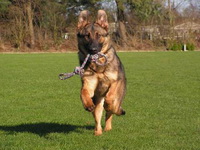What is dog functionality?
 Not even the most intelligent and powerful dog can master all dog professions and perform all the functions without exception. As no living organism can be universal and act reliably in any conditions. Features of a dog can be divided into: basic features; basic behavioral responses; functional qualities.
Not even the most intelligent and powerful dog can master all dog professions and perform all the functions without exception. As no living organism can be universal and act reliably in any conditions. Features of a dog can be divided into: basic features; basic behavioral responses; functional qualities.
1. The basic features include: pedigree characteristics; health, physical development; personality psychological characteristics.
Under the breed characteristics means the specific behavior and features of the exterior of a particular breed. When buying a dog, it is imperative to consider the compliance of the breed characteristics with the selected service. For example, a huge heavy mastiff man knocked to the ground with one jerk of powerful jaws, but at the same time he is not able to jump in height in sports, as does an easy and graceful Doberman. The Fox Terrier can be physically well developed, have a strong nervous system, and even undergo a course of protective training, but in reality it is simply not capable of becoming a bodyguard dog. Thus, an objective assessment of the advantages and disadvantages of the breed is a fundamental factor when choosing a dog. Breed is not only a genetically fixed set of external characteristics of the animal’s appearance, but also its typical nature, behavior pattern, character.
In addition to the features of the anatomical structure, the ability to perform a particular activity determines the health indicators and physical development of the dog. Naturally, the basic indicators of health are of great importance. Congenital malformations are often incompatible with life, so puppies with gross organ and system disorders die in the first days or months of life. However, there are many hereditary pathologies with which dogs live until old age, but at the same time suffer from various chronic diseases.
As in the course of the course of training, and during subsequent work the animal’s body is experiencing great physical and psychological stress. For example, to obtain a diploma of the third (highest) degree in the German Shutzhund training system (Schutz ‑ hund), a dog must be impeccably executed a course of obedience – in particular, the ability to overcome a deaf barrier 180 cm in height, as well as completing an item weighing 2 kg per flat terrain and weighing 650 grams with a jump over a meter barrier. The course of defense includes not only detection and barking, but also the detention and prosecution of the “savvy malefactor”. In other words, a working dog should not be afraid to fight a man and have the strength to win it.
It is clear that only a healthy, physically developed animal, not burdened by poor heredity and chronic diseases, can withstand such a hard rhythm. For example, a dog with defects in the development of the musculoskeletal system, who has suffered an injury or has a weak development of the skeleton and muscles, has a low efficiency of its activity. She quickly gets tired and tries to lie down, is distracted by pain and is lame, so she is simply not able to perform a high-jump or endurance run. A dog with a problem stomach requires a special diet, inactively reacts to food stimuli, and is often depressed, experiencing nausea and pain. All this once again underlines the need for a responsible attitude to your pet, providing it with a balanced diet, providing active exercise, as well as the necessary veterinary care.
The functionality of a dog is largely determined by its psychological qualities, which are based on temperament, as a congenital set of personal characteristics. For whatever service you plan to use a dog, it must have a strong and balanced temperament. It is this quality that determines whether your dog will work actively and for a long time during training and how intensively the learning process will go.
Dominance is associated with protective instinct and is inherent in the so-called “hard” dogs. Such a dog will not retreat and will not fail in a real battle. She is able to perform defensive work under the onslaught of an attacker who actively resists, shouts, applies blows and other strong stimuli. The rage of the attack only boosts the strength and strength of these dogs. In contrast, a “soft” dog may at first demonstrate serious aggression, bark, grin, and growl menacingly, but under the pressure of the attacker, it will certainly pass to retreat. Physical pain and psychological pressure will intimidate her, and the instinct of passive protection will prevail over the demand to repulse. It also depends on the strength of the nervous system whether the dog is able to follow a long distance, to search for explosives under adverse weather conditions for a long time, and generally perform its functions in extreme conditions.



